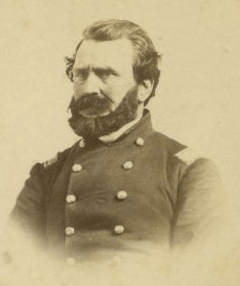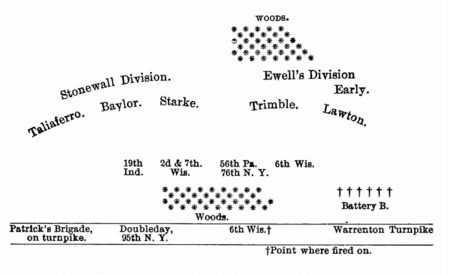William W. Robinson facts for kids
Quick facts for kids
William W. Robinson
|
|
|---|---|
 |
|
| Born | December 14, 1819 Fair Haven, Vermont, U.S. |
| Died | April 27, 1903 (aged 83) Seattle, Washington, U.S. |
| Buried |
Fort Lawton Cemetery, Fort Lawton, Washington
|
| Allegiance | United States |
| Service/ |
United States Army Union Army |
| Years of service | 1846–1848 1861–1865 |
| Rank | Colonel, USV |
| Commands held | 7th Reg. Wis. Vol. Infantry Iron Brigade |
| Battles/wars | Mexican–American War
|
| Alma mater | Norwich Military Academy |
| Spouse(s) | Sarah Jane Fisk |
| Children |
|
| Other work | U.S. consul to Madagascar (1875–1887) |
William Wallace Robinson, Sr. (born December 14, 1819 – died April 27, 1903) was an important officer in the Union Army during the American Civil War. He led the 7th Wisconsin Infantry Regiment in the famous Iron Brigade. After the war, he became a U.S. consul (a diplomat who helps citizens and promotes trade) in Madagascar for 12 years.
Contents
Early Life and Military Start
William Robinson was born in Fair Haven, Vermont, in 1819. His family had moved to Vermont after the War of 1812. He went to Castleton Academy and then to Norwich Military Academy.
After school, Robinson taught in Vermont, New Jersey, and Ohio. In 1840, he moved to Cleveland, Ohio. He later explored land in the Wisconsin Territory but returned to Ohio. There, he joined the army for the Mexican–American War. He became a lieutenant and later a captain. He fought in small battles along the San Juan River.
After the war, he worked as a contractor during the California Gold Rush. Then he moved to the Minnesota Territory. He helped start the town of Wilton. In Minnesota, he became a colonel in the local army and helped train soldiers.
Civil War Service
In 1858, Robinson moved to Sparta, Wisconsin. When the American Civil War began, he was made a lieutenant colonel in the 7th Wisconsin Infantry Regiment. His regiment left Wisconsin in September 1861 to fight in the eastern part of the war.
Joining the Iron Brigade
The 7th Wisconsin Infantry arrived near Washington, D.C., in October 1861. They joined a group of regiments that would become known as the Iron Brigade. This group included the 2nd Wisconsin, 6th Wisconsin, and 19th Indiana regiments. They spent the fall building forts and guarding railroad bridges around Washington, D.C..
Soon after, Lieutenant Colonel Robinson took command of the 7th Wisconsin Infantry. He was then promoted to colonel. Colonel Robinson led the regiment for the next three years of the war.
Battles in Virginia (1862)
In the spring of 1862, Robinson's regiment moved into Confederate land for the first time. They went to Falmouth, Virginia, near the Rappahannock River. They were ready to help General McClellan's army but were called away to chase a Confederate general named Stonewall Jackson.
In July, the Iron Brigade was ordered to attack Confederate supply lines south of the Rappahannock. They tried to cut the Virginia Central Railroad. The 7th Wisconsin and 2nd Wisconsin regiments met Confederate cavalry. They realized a large enemy force was nearby.
The Battle of Second Bull Run
On August 9, 1862, Robinson's brigade was ordered to help General Pope. They arrived after the Battle of Cedar Mountain was over. They helped bury the dead and then fought in small battles along the Rappahannock River.
On August 28, Robinson's brigade met Stonewall Jackson's army near Gainesville, Virginia. Their general thought the Confederates were a small force. But when the Confederates started firing cannons, Robinson's brigade was ordered to attack. A fierce battle began. Robinson's brigade, though greatly outnumbered, held their ground. This battle is sometimes called the "Battle of Gainesville" and was the first day of the Second Battle of Bull Run.
This is also where the nickname "Iron Brigade" was first used for their unit. The 2nd and 7th Wisconsin regiments suffered many injuries. Colonel Robinson was shot in the leg, breaking a bone. He had to leave the battlefield and spent three months recovering. He missed the Battle of Antietam.
Winter Campaigns (1862-1863)
Colonel Robinson returned to the 7th Wisconsin in December 1862. He led the regiment through two winter campaigns near Fredericksburg, Virginia. These were the Battle of Fredericksburg and the difficult Mud March. They did not fight in major battles during these times. The Iron Brigade spent most of the winter resting and getting new supplies. President Abraham Lincoln even visited their camp.
In April, the fighting started again with the Battle of Chancellorsville. The 7th Wisconsin and the Iron Brigade acted as the rearguard (protecting the army from behind) as the Union army retreated.
Gettysburg: A Major Battle
After Chancellorsville, General Robert E. Lee prepared for another attack into the North. The 7th Wisconsin helped scout the area. They met Lee's cavalry near Brandy Station, Virginia, and fought in the Battle of Brandy Station on June 9.
For days, they marched quickly toward Pennsylvania to stop Lee's attack. On July 1, the first day of the Battle of Gettysburg, the Iron Brigade was at the front. They were the second group of soldiers to set up their battle line on McPherson Ridge. General John F. Reynolds, their commander, was shot and killed while giving orders to the brigade.
The Iron Brigade fought bravely. They surrounded and captured a Confederate general, James J. Archer, and his soldiers. Archer was the first Confederate general captured in the war. Later that day, the Iron Brigade was attacked from two sides. After a tough fight, they had to fall back. General Solomon Meredith, who commanded the Iron Brigade, was wounded. Colonel Robinson was ordered to take command of the brigade and led them for the rest of the battle.
The Iron Brigade held their ground against strong Confederate attacks. They later moved to Culp's Hill and built defenses. On July 2 and 3, the brigade faced artillery fire but no direct attacks. Over half of the Iron Brigade soldiers were killed or wounded at Gettysburg, mostly on the first day.
Later Campaigns (1863-1864)
After Gettysburg, the Iron Brigade returned to Virginia. They participated in the Bristoe campaign and the Battle of Mine Run, but did not see major fighting.
In January 1864, many soldiers in the 7th Wisconsin chose to re-enlist. Colonel Robinson and these veterans went home to Wisconsin for a break. They were celebrated by the governor.
The Overland Campaign
In March 1864, General Ulysses S. Grant took command of the Union Army in Virginia. The Iron Brigade was reorganized. General Lysander Cutler took command of the Iron Brigade again, and Robinson returned to leading the 7th Wisconsin Infantry.
On May 5, 1864, the Iron Brigade fought in the Battle of the Wilderness. The fighting was confusing in the woods. The next day, they attacked the Confederate lines but were pushed back. Colonel Robinson spoke to General Wadsworth just before the general was shot and fatally wounded.
After General Wadsworth's death, General Cutler took command of the division, and Colonel Robinson was again put in charge of the Iron Brigade.
The army then moved toward Spotsylvania Court House. During the Battle of Spotsylvania Court House, the Iron Brigade attacked Confederate forts four times. They also fought at a place called the "Bloody Angle."
After Spotsylvania, the army continued moving south. They crossed the North Anna River and fought in the Battle of North Anna. After more days of fighting, Grant ordered the army to move south again. They fought in the Battle of Totopotomoy Creek and then the Battle of Cold Harbor. On June 6, Colonel Robinson was replaced as commander of the Iron Brigade and resigned from the army.
Life After the War
Colonel Robinson returned to Sparta, Wisconsin, and managed his farm for ten years. In 1873, he moved to Chippewa Falls, Wisconsin. In 1875, President Ulysses S. Grant made him a U.S. consul to the Merina Kingdom of Madagascar. A consul is like a country's representative in another country, helping with trade and citizens. Colonel Robinson served for twelve years. In 1882, the Queen of Madagascar even asked him to travel with her ambassadors on a trip to the United States and Europe.
In 1886, a new president, Grover Cleveland, did not renew Robinson's job, so he returned to Wisconsin. He bought a share in his son's coal business. He also joined the Iron Brigade veterans association and was elected vice president.
In his later years, Colonel Robinson lived with his son, William Jr., in Seattle, Washington. His son was a quartermaster (in charge of supplies) for the U.S. Army. Colonel Robinson died at his son's home on April 27, 1903.
Family Life
William Robinson's father, John W. Robinson, was a lieutenant in the Connecticut Militia during the War of 1812. The Robinsons were related to John Robinson, one of the leaders of the Pilgrims who planned the Mayflower voyage. William's brother, Andrew N. Robinson, also served with the 7th Wisconsin Infantry.
William Robinson married Sarah Jane Fisk. They had five children, but two died when they were young. Colonel Robinson helped his oldest son, William Jr., get into the United States Military Academy (West Point). William W. Robinson, Jr., had a 40-year career in the U.S. Army and became a brigadier general. He served with the 7th U.S. Cavalry Regiment and was involved in events after the Battle of Little Bighorn. He also helped donate his family's land in Sparta, Wisconsin, for military use. This land is now part of Fort McCoy.
During the first winter of the Civil War, Colonel Robinson's family joined him at camp. His daughter Leonora fell in love with a soldier under his command, Hollon Richardson. Colonel Robinson did not approve, but Leonora and Richardson ran away and got married in Washington, D.C.. Colonel Robinson was upset at first, but they later became good friends. Richardson became an officer and fought bravely at Gettysburg. After the war, Colonel Robinson lived with Leonora and Richardson for a while.



